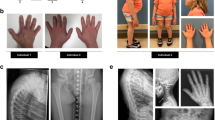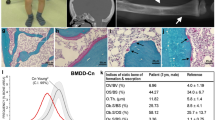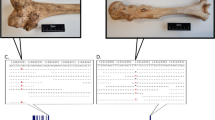Abstract
Hereditary multiple exostoses (HME) is an autosomal dominant disorder characterized by the formation of cartilage-capped tumours (exostoses) that develop from the growth plate of endochondral bone1. This condition can lead to skeletal abnormalities, short stature and malignant transformation of exostoses to chondrosarcomas2,3 or osteosarcomas4,5. Linkage analyses have identified three different genes for HME, EXT1 on 8q24.1, EXT2 on 11p11–13 and EXT3 on 19p (refs 6, 7, 8, 9). Most HME cases have been attributed to missense or frameshift mutations in these tumour-supressor genes, whose functions have remained obscure. Here, we show that EXT1 is an ER-resident type II transmembrane glycoprotein whose expression in cells results in the alteration of the synthesis and display of cell surface heparan sulfate glycosaminoglycans (GAGs). Two EXT1 variants containing aetiologic missense mutations10 failed to alter cell-surface glycosaminoglycans, despite retaining their ER-localization.
This is a preview of subscription content, access via your institution
Access options
Subscribe to this journal
Receive 12 print issues and online access
$209.00 per year
only $17.42 per issue
Buy this article
- Purchase on Springer Link
- Instant access to full article PDF
Prices may be subject to local taxes which are calculated during checkout





Similar content being viewed by others
References
Solomon, L. Hereditary multiple exostosis. J. Bone Joint Surg. 45, 292–304 (1963).
Hennekam, R.C. Hereditary multiple exostoses. J. Med. Genet. 28, 262 –266 (1991).
Leone, N.C. et al. Hereditary multiple exostosis. A comparative human-equine-epidemiologic study. J. Hered. 78, 171–177 (1987).
Schmale, G.A., Conrad, E.U. Raskind, W.H. The natural history of hereditary multiple exostoses. J. Bone Joint Surg. Am. 76, 986–992 ( 1994).
Luckert-Wicklund, C., Pauli, R., Johnston, D. Hecht, J. Natural history of hereditary multiple exostoses. Am. J. Med. Genet. 55, 43–46 (1995).
Ahn, J. et al. Cloning of the putative tumour suppressor gene for hereditary multiple exostoses (EXT1). Nature Genet. 11, 137–143 (1995).
Cook, A. et al. Genetic heterogeneity in families with hereditary multiple exostoses. Am. J. Hum. Genet. 53, 71–79 (1993).
LeMerrer, M. et al. A gene for hereditary multiple exostoses maps to chromosome 19p. Hum. Mol. Genet. 3, 717–722 (1994).
Wu, Y.Q. et al. Assignment of a second locus for multiple exostoses to the pericentromeric region of chromosome 11. Hum. Mol. Genet. 3, 167–171 (1994).
Philippe, C. et al. Mutation screening of the EXT1 and EXT2 genes in patients with hereditary multiple exostoses. Am. J. Hum. Genet. 61, 520–528 (1997).
WuDunn, D. Spear, P.G. Initial interaction of herpes simplex virus with cells is binding to heparan sulfate. J. Virol. 63, 52–58 (1989).
Herold, B.C., Visalli, R.J., Susmarski, N., Brandt, C.R. Spear, P.G. Glycoprotein C-independent binding of herpes simplex virus to cells requires cell surface heparan sulphate and glycoprotein B. J. Gen. Virol. 75, 1211–1222 ( 1994).
Herold, B.C., WuDunn, D., Soltys, N. Spear, P.G. Glycoprotein C of herpes simplex virus type 1 plays a principal role in the adsorption of virus to cells and in infectivity. J. Virol. 65, 1090–1098 (1991).
Cai, W., Gu, B. Person, S. Role of glycoprotein B of herpes simplex virus type 1 in viral entry and cell fusion. J. Virol. 62, 2596–2604 (1988).
Banfield, B.W., Leduc, Y., Esford, L., Schubert, K. Tufaro, F. Sequential isolation of proteoglycan synthesis mutants by using herpes simplex virus as a selective agent: evidence for a proteoglycan-independent virus entry pathway. J. Virol. 69, 3290–3298 (1995).
Gruenheid, S., Gatzke, L., Meadows, H. Tufaro, F. Herpes simplex virus infection and propagation in a mouse L cell mutant lacking heparan sulfate proteoglycans. J. Virol. 67, 93–100 (1993).
Schutze, M.P., Peterson, P.A. Jackson, M.R. An N-terminal double-arginine motif maintains type II membrane proteins in the endoplasmic retiuculum. EMBO J. 13, 1696–1705 (1994).
Teasdale, R.D. Jackson, M.R. Signal-Mediated Sorting of Membrane Proteins Between the Endoplasmic Reticulum and the Golgi Apparatus. Annu. Rev. Cell Dev. Biol. 12, 27–54 (1996).
Hecht, J.T. et al. Hereditary multiple exostoses (EXT): mutational studies of familial EXT1 cases and EXT-associated malignancies. Am. J. Hum. Genet. 60, 80–86 (1997).
Bernstein, L.R. Liotta, L.A. Molecular mediators of interactions with extracellular matrix components in metastasis and angiogenesis. Curr. Opin. Oncol. 6, 106–113 (1994).
Tuszynski, G.P., Wang, T.N. Berger, D. Adhesive proteins and the hematogenous spread of cancer. Acta Haematol. 97, 29–39 ( 1997).
Schamhart, D.H. Kurth, K.H. Role of proteoglycans in cell adhesion of prostate cancer cells: from review to experiment. Urol. Res. 25, S89–96 ( 1997).
Esko, J.D., Rostand, K.S. Weinke, J.L. Tumour formation dependent on proteoglycan biosynthesis. Science 241, 1092–1096 ( 1988).
Iida, J., Meijne, A.M., Knutson, J.R., Furcht, L.T. McCarthy, J.B. Cell surface chondroitin sulfate proteoglycans in tumour cell adhesion, motility and invasion. Semin. Cancer Biol. 7, 155–162 (1996).
Iozzo, R.V. Cohen, I. Altered proteoglycan gene expression and the tumour stroma. Experientia 49, 447–455 (1993).
Wise, C.A., Clines, G.A., Massa, H., Trask, B.J. Lovett, M. Identification and localization of the gene for EXTL, a third member of the multiple exostoses gene family. Genome Res. 7, 10–16 (1997).
Wuyts, W. et al. Identification and characterization of a novel member of the EXT gene family, EXTL2. Eur. J. Hum. Genet. 5, 382–389 (1997).
Van Hul, W. et al. Identification of a Third EXT-like Gene (EXTL3) Belonging to the EXT Gene Family. Genomics 47, 230–237 (1998).
Esko, J.D., Stewart, T.E. Taylor, W.H. Animal cell mutants defective in glycosaminoglycan biosynthesis. Proc. Natl. Acad. Sci. USA 82, 3197–3201 (1985).
Bame, K.J. Esko, J.D. Undersulfated heparan sulfate in a Chinese hamster ovary cell mutant defective in heparan sulfate N-sulfotransferase. J. Biol. Chem. 264, 8059–8065 (1989).
Acknowledgements
We thank B. Roizman and L. Enquist for helpful discussions. This work was supported by grants to F.T. from the Medical Research Council of Canada and the Canadian Genetic Diseases Network.
Author information
Authors and Affiliations
Corresponding author
Rights and permissions
About this article
Cite this article
McCormick, C., Leduc, Y., Martindale, D. et al. The putative tumour suppressor EXT1 alters the expression of cell-surface heparan sulfate. Nat Genet 19, 158–161 (1998). https://doi.org/10.1038/514
Received:
Accepted:
Issue Date:
DOI: https://doi.org/10.1038/514
This article is cited by
-
Endothelial cell-specific reduction of heparan sulfate suppresses glioma growth in mice
Discover Oncology (2021)
-
Specific functions of Exostosin-like 3 (EXTL3) gene products
Cellular & Molecular Biology Letters (2020)
-
An overview of chondrosarcoma with a focus on nanoscale therapeutics
Journal of Pharmaceutical Investigation (2020)
-
Heparan sulfate is an important mediator of Ebola virus infection in polarized epithelial cells
Virology Journal (2018)
-
A fast approach to detect gene–gene synergy
Scientific Reports (2017)



